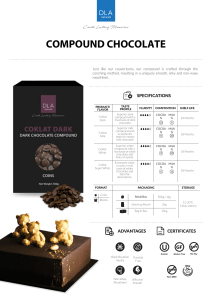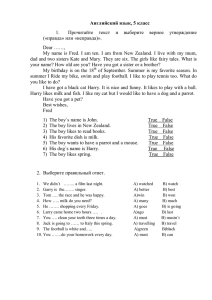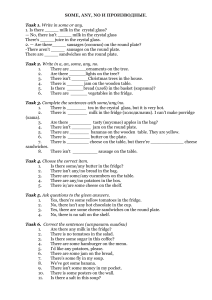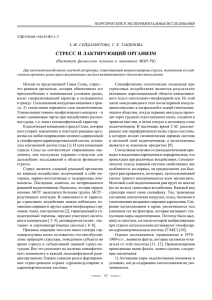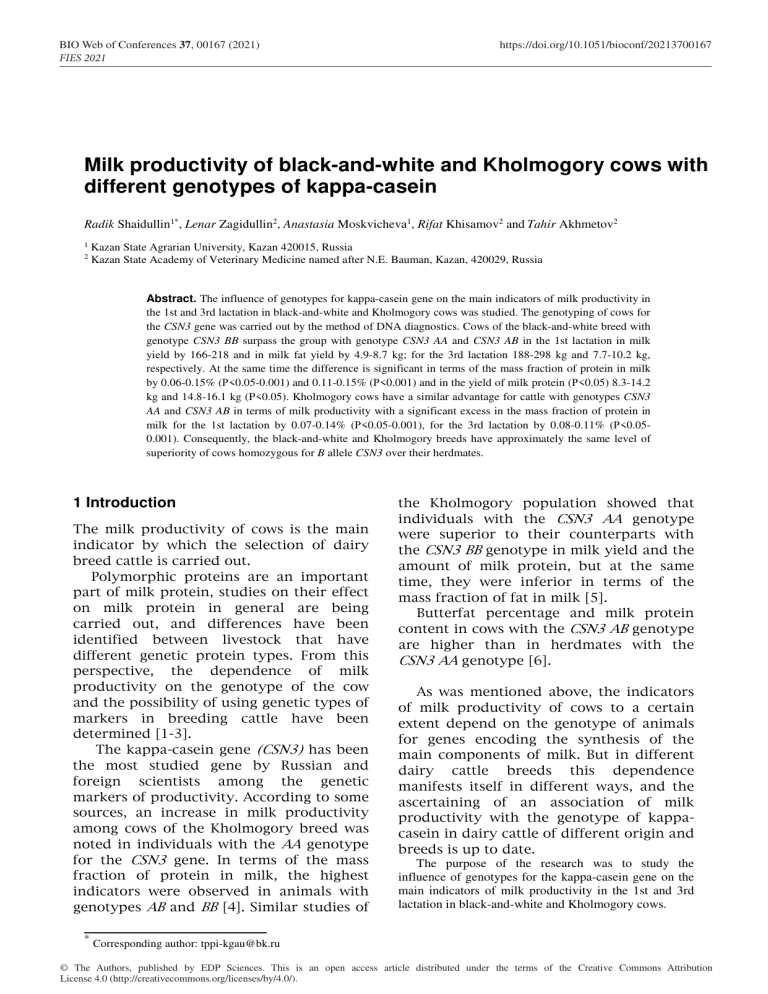
BIO Web of Conferences 37, 00167 (2021) FIES 2021 https://doi.org/10.1051/bioconf/20213700167 Milk productivity of black-and-white and Kholmogory cows with different genotypes of kappa-casein Radik Shaidullin1*, Lenar Zagidullin2, Anastasia Moskvicheva1, Rifat Khisamov2 and Tahir Akhmetov2 1 Kazan State Agrarian University, Kazan 420015, Russia 2 Kazan State Academy of Veterinary Medicine named after N.E. Bauman, Kazan, 420029, Russia Abstract. The influence of genotypes for kappa-casein gene on the main indicators of milk productivity in the 1st and 3rd lactation in black-and-white and Kholmogory cows was studied. The genotyping of cows for the CSN3 gene was carried out by the method of DNA diagnostics. Cows of the black-and-white breed with genotype CSN3 BB surpass the group with genotype CSN3 AA and CSN3 AB in the 1st lactation in milk yield by 166-218 and in milk fat yield by 4.9-8.7 kg; for the 3rd lactation 188-298 kg and 7.7-10.2 kg, respectively. At the same time the difference is significant in terms of the mass fraction of protein in milk by 0.06-0.15% (Р<0.05-0.001) and 0.11-0.15% (Р<0.001) and in the yield of milk protein (Р<0.05) 8.3-14.2 kg and 14.8-16.1 kg (P<0.05). Kholmogory cows have a similar advantage for cattle with genotypes CSN3 AA and CSN3 AB in terms of milk productivity with a significant excess in the mass fraction of protein in milk for the 1st lactation by 0.07-0.14% (Р<0.05-0.001), for the 3rd lactation by 0.08-0.11% (Р<0.050.001). Consequently, the black-and-white and Kholmogory breeds have approximately the same level of superiority of cows homozygous for B allele CSN3 over their herdmates. 1 Introduction The milk productivity of cows is the main indicator by which the selection of dairy breed cattle is carried out. Polymorphic proteins are an important part of milk protein, studies on their effect on milk protein in general are being carried out, and differences have been identified between livestock that have different genetic protein types. From this perspective, the dependence of milk productivity on the genotype of the cow and the possibility of using genetic types of markers in breeding cattle have been determined [1-3]. The kappa-casein gene (CSN3) has been the most studied gene by Russian and foreign scientists among the genetic markers of productivity. According to some sources, an increase in milk productivity among cows of the Kholmogory breed was noted in individuals with the AA genotype for the CSN3 gene. In terms of the mass fraction of protein in milk, the highest indicators were observed in animals with genotypes AB and BB [4]. Similar studies of * the Kholmogory population showed that individuals with the CSN3 AA genotype were superior to their counterparts with the CSN3 BB genotype in milk yield and the amount of milk protein, but at the same time, they were inferior in terms of the mass fraction of fat in milk [5]. Butterfat percentage and milk protein content in cows with the CSN3 AB genotype are higher than in herdmates with the CSN3 AA genotype [6]. As was mentioned above, the indicators of milk productivity of cows to a certain extent depend on the genotype of animals for genes encoding the synthesis of the main components of milk. But in different dairy cattle breeds this dependence manifests itself in different ways, and the ascertaining of an association of milk productivity with the genotype of kappacasein in dairy cattle of different origin and breeds is up to date. The purpose of the research was to study the influence of genotypes for the kappa-casein gene on the main indicators of milk productivity in the 1st and 3rd lactation in black-and-white and Kholmogory cows. Corresponding author: tppi-kgau@bk.ru © The Authors, published by EDP Sciences. This is an open access article distributed under the terms of the Creative Commons Attribution License 4.0 (http://creativecommons.org/licenses/by/4.0/). BIO Web of Conferences 37, 00167 (2021) FIES 2021 https://doi.org/10.1051/bioconf/20213700167 2 Materials and Methods Russian basic norm of the mass fraction of protein and fat was determined by the formula: First-calf heifers and full-aged black-andwhite and Kholmogory cows, from which blood samples were taken and DNA samples were isolated, were selected for research in the conditions of the breeding reproducer of OOO «Dusym» (Dusym,LLC) of Atninsky District and OAO «Plemzavod Biryulinsky» (Plemzavod Biryulinsky, JSC) in Vysokogorsky District of the Republic of Tatarstan. The material for DNA testing was venous blood of experimental animals. DNA was isolated from each blood sample using the kit “Magnosorb” (Interlabservis, Moscow, Russia) according to the manufacturer's instructions. The CSN3 gene was studied by polymerase chain reaction method followed by analysis of restriction fragment length on polymorphism (PCR-RFLP) using the forward primer 5'TAGCCAAATATATCCCAATTCAGT-3' and reverse primer 5'TTTATTAATAAGTCCATGAATCTTG -3 [7]. Amplification with primers was performed by amplifier “Tertsik” (“DNA technology”, Moscow, Russia) according to standard practice. It was used as the PCR mixture of the following composition: a pair of primers for amplification of the studied gene, a mixture of nucleoside triphosphates (2.5 mM), magnesium chloride (25mМ), tenfold PCR buffer, Taq polymerase. The derived amplicons were exposed to restriction using restriction enzymes Hinf I (CSN3 gene) (SibEnzyme, Russia) according to the manufacturer's recommendations. After hydrolysis, the amplicon fragments were exposed to horizontal electrophoresis in a 2.5% agarose gel. Depending on the presence of alleles A and B of CSN3 gene, genotypes were divided into three groups (AA, AB, BB). Data on milk production of cows with different CSN3 genotypes were used for the research. The economic efficiency of milk production from cows with different genotypes was determined according to the "Methodological recommendations for determining the economic efficiency from the implementation of the results of the research in animal breeding" [8]. The amount of milk in terms of the all- W fp = Wav × Fav × Pav , Fb × Pb (1) where Wfp – conventional value of net content weight of raw milk, kg; Wav – actual value of net content weight of raw milk, kg; Fav – actual value of mass fraction of fat, %; Pav – actual value of the mass fraction of protein, %; Fb – basic all-Russian norm of mass fraction of fat, %; Pb – basic all-Russian norm of protein mass fraction, %. The obtained materials were statistically processed using the Microsoft Excel software from the Microsoft Office 2007 software package. The materials were statistically processed followed by the calculation of the arithmetic mean (M) and arithmetic mean error (m) in the Microsoft Excel 2007 software application. The level of reliability of the results was determined by the Student's criterion. 3 Results As a result of the carried out studies on polymorphism of kappa-casein gene in dairy cattle, the following data were obtained. 67% (101 cows) have the AA genotype of kappa-casein gene from the selected 151 first-calf cows of the black-and-white breed, 29% (44 cows) have the CSN3 AB genotype (44 cows), and only 4% (6 cows) have the CSN3 BB genotype (table 1), while the frequency of allele A was 0.81, and allele B was 0.19. In the group of full-grown cows 109 cows were identified with the CSN3 AA genotype, 52 cows were with the heterozygous CSN3 AB genotype, and only 7 cows were with the desired homozygous CSN3 BB genotype. The frequency of genotypes reached: АА – 65%, АВ – 31%, ВВ – 4%. However, the frequency of allele A was 0.80 and the frequency of the desired allele B was 0.20. The milk yield per lactation was higher in the firstcalf heifers of the black-and-white breed with CSN3 BB genotype in comparison with CSN3 AA animals by 218 kg and CSN3 AB genotype by 166 kg. The amount of milk fat and protein increased by 8.7 kg, 4.9 kg and 14.2 kg, 8.3 kg, respectively (table 2), while the difference is significant only in the yield of milk protein (P<0.05). The animals with the desired allele B of kappa-casein significantly exceeded the CSN3 AA group in terms of the mass fraction of protein in milk by 0.06-0.15% (P <0.05-0.001). A significant difference was also noted between the CSN3 AB and CSN3 AA groups in favor of heterozygous firstcalf heifers, that was 0.09% (P <0.001). 2 BIO Web of Conferences 37, 00167 (2021) FIES 2021 https://doi.org/10.1051/bioconf/20213700167 The animals with the CSN3 AB genotype had the mass fraction of fat in milk 3.79%, which was 0.03% higher than in cows with the CSN3 BB genotype and significantly higher than in first-calf heifers with the CSN3 AA genotype by 0.04% (P <0.05). As for full-grown cows, the advantage of animals with the B allele of the kappacasein locus in their genome was also noted. Thus, cows with genotype CSN3 BB surpass the group with genotype CSN3 AA by 188 kg in milk yield, CSN3 AB - by 298 kg; by the yield of milk fat - by 7.7 kg and 10.2 kg. By mass fraction of protein it was by 0.15% (P <0.001) and 0.11% (P <0.001); by the yield of milk protein - by 14.8 kg and 16.1 kg (P<0.05), respectively. The best butterfat percentage was noted in heterozygous cows that was 3.80%, exceeding other groups by 0.02-0.03%. Consequently, it was revealed that the highest milk productivity in black-and-white cattle is characteristic of cows with allelic variants AB and BB of the kappa-casein gene, irrespective of age. Our data conform to the studies of F.F. Zinnatova et al. (2010) and Shaydullina R.R. et al. (2015), according to which there is an advantage in milk productivity in black-and-white cattle with the B allele of kappa-casein [9-10]. Among cows of Kholmogory breed, CSN3 AA genotype was identified in 64-65%; 31-33% had CSN3 AB genotype, and 4% had the most desirable CSN3 BB genotype (table 3). The frequency of A allele was 0.80, and B allele was 0.20. Kholmogory first-calf heifers with genotype CSN3 AB are characterized by high milk productivity and surpass other groups in milk yield by 118-164 kg, in fat mass fraction in milk by 0.01-0.04%, in milk fat yield by 5.1-8.4 kg, according to the yield of milk protein by 0.48.8 kg (table 4). The cows with the CSN3 BB genotype have an advantage in terms of the mass fraction of protein in milk by 0.07-0.14% (P <0.05-0.001). Full-grown cows with genotype CSN3 BB have an advantage in milk yield by 79-100 kg, in the amount of milk fat by 1.9-5.0 kg, in the amount of milk protein by 7.3-9.8 kg, the mass fraction of protein in milk - by 0.080.11% (Р<0.05-0.001). Thus, it is necessary to identify dairy cattle with genotypes CSN3 AB and CSN3 BB to conduct a homogeneous selection of parental pairs and selection for breeding animals with the allelic variant B of kappacasein in the genotype. Similar results were obtained in the studies of Sh.K. Shakirov, Yu.R. Yulmetyeva, F.F. Zinnatova (2012), who noted an increase in milk yield, milk fat and protein yield in animals of the Kholmogory breed with the B allele in the genome of kappa-casein of CSN3 gene [11]. It should be noted that animals of the analyzed groups, regardless of breed and age, carrying the allele B of kappa-casein in their genome, have an increased butterfat percentage and milk protein content. Similar results on obtaining high milk yields and higher milk protein from cows of various breeds with the B allele of kappa-casein in the genotype were found in both domestic [12-14] and foreign cattle [15-17]. In dairy farming the efficiency of production is an important issue that is mainly determined by the level of milk productivity of cows and the selling price of a unit of dairy products. The higher the productivity of animals and the purchase price of milk, the lower the cost per unit of manufactured products and the higher the profit from sales. Taking this into account, an analysis of the economic efficiency of milk production from black-and-white and Kholmogory cows with different genotypes of kappa-casein was carried out. Table 1. Frequency of occurrence of genotypes and alleles of kappa-casein gene in black-and-white cows. Genotype frequency, % Total livestock ММ ММ Allele frequency ММ n % n % n % 1st lactation n % М М 151 100 101 67 44 6 4 0.81 0.19 168 100 109 65 3rd lactation 52 31 7 4 0.80 0.20 29 Table 2. Milk productivity of cows in the 1st and 3rd lactation of black-and-white breed with different genotypes of kappa-casein Indicators CSN3 genotype ММ ММ 1st lactation 3 ММ BIO Web of Conferences 37, 00167 (2021) FIES 2021 https://doi.org/10.1051/bioconf/20213700167 n Milk yield, kg 101 4593 ± 38.2 44 4645 ± 65.3 6 4811 ± 166.5 Fat, % 3.75 ± 0.010 3.79 ± 0.016 3.76 ± 0.021 Milk fat, kg 172.2 ± 1.57 176.0 ± 2.59 180.9 ± 5.57 Protein, % 3.18 ± 0.006 3.27 ± 0.011 3.33 ± 0.024 Milk protein, kg 146.0 ± 1.20 3rd lactation 151.9 ± 2.25 160.2 ± 5.68 n Milk yield, kg Fat, % Milk fat, kg Protein, % Milk protein, kg 109 5698 ± 45.3 3.77 ± 0.010 214.8 ± 1.63 3.19 ± 0.007 181.8 ± 1.55 52 5588 ± 71.1 3.80 ± 0.018 212.3 ± 2.03 3.23 ± 0.012 180.5 ± 1.71 7 5886 ± 151.2 3.78 ± 0.041 222.5 ± 9.39 3.34 ± 0.023 196.6 ± 7.81 Table 3. Frequency of occurrence of genotypes and alleles of the kappa-casein gene in cows of Kholmogory breed Genotype frequency, % Total livestock ММ ММ n % n % 160 100 103 65 143 100 92 64 Allele frequency ММ n % 1st lactation 50 31 3rd lactation 45 33 4 n % М М 7 4 0.80 0.20 6 4 0.80 0.20 BIO Web of Conferences 37, 00167 (2021) FIES 2021 https://doi.org/10.1051/bioconf/20213700167 Table 4. Milk productivity of cows in the 1st and 3rd lactation of the Kholmogory breed with different genotypes of kappa-casein Indicators CSN3 genotype ММ ММ ММ 50 5110 ± 93.5 3.90 ± 0.026 199.3 ± 3.96 3.29 ± 0.013 168.1 ± 3.45 7 4992 ± 133.2 3.89 ± 0.034 194.2 ± 4.43 3.36 ± 0.033 167.7 ± 4.48 45 5812 ± 73.4 3.88± 0.018 225.5 ± 2.03 3.26 ± 0.011 189.5 ± 1.84 6 5891 ± 106.8 3.86 ± 0.033 227.4 ± 5.62 3.34 ± 0.028 196.8 ± 4.43 1st lactation n Milk yield, kg Fat, % Milk fat, kg Protein, % Milk protein, kg 103 4946 ± 64.9 3.86 ± 0.019 190.9 ± 2.89 3.22 ± 0.006 159.3 ± 2.37 3rd lactation 92 5791 ± 47.0 3.84 ± 0.014 222.4 ± 1.77 3.23 ± 0.007 187.0 ± 1.67 n Milk yield, kg Fat, % Milk fat, kg Protein, % Milk protein, kg The economic efficiency of milk production from cows with different genotypes for kappa-casein was calculated for practical assessment of the carried out research. During calculation the indicators of milk productivity of animals and the average selling price of 1 kg of raw milk were used, while the productivity was recalculated taking into account the basic all-Russian norm of the mass fraction of fat and protein. During calculation of the economic efficiency of milk production, black-andwhite cows with genotypes CSN3 AB and CSN3 BB compared to CSN3 AA animals produced more milk in the 1st lactation by 5.1-10.0% and the 3rd lactation by 0.98.4%, with additional production per head in the amount of 4724-9263 rubles and 1043-9734 rubles (table 5). protein and fat was received, kg Increase of the main kg products (milk) % Cost of additional products per head, rubles Genotype CSN3 АА АВ ВВ (base case) 1st lactation Milk of the basic all-Russian norm of the mass fraction of 5370 protein and fat was received, kg Increase of the main kg products (milk) % Cost of additional products per head, rubles 3rd lactation Milk of the basic all-Russian 6718 norm of the mass fraction of 5644 5906 274 536 5.1 10.0 4724 9263 6724 7285 6 0.9 426 8.4 - 1043 9734 A similar pattern of higher milk production per head can be observed in Kholmogory cattle with genotypes CSN3 AB and CSN3 BB, for the 1st lactation by 6.16.6% and the 3rd lactation by 2.3-5.7%, also an additional profit from a cow was received in 6342-6862 rubles and 27946924 rubles, respectively (table 6). When comparing economic indicators in the context of breeds, it was revealed that black-and-white cows with the CSN3 BB genotype exceed their analogues in the 1st lactation by 2921 rubles and the 3rd lactation by 2810 rubles, and Kholmogory cattle with the CSN3 AB genotype have more proceeds in cash per head in the amount of 2138 rubles and 1751 rubles. Therefore, the efficiency of milk production is the best from cows with the B allele of kappa-casein because it contributes to additional profit from the sale of raw milk. Table 5. Efficiency of milk production from black-and-white cows with different genotypes of kappa-casein Indicators - Table 6. Efficiency of milk production from cows of the Kholmogory breed with different genotypes of kappa-casein Indicators Genotype CSN3 АА АВ ВВ (base case) 1st lactation Milk of the basic allRussian norm of the mass 6027 6428 6397 fraction of protein and fat 5 BIO Web of Conferences 37, 00167 (2021) FIES 2021 was received, kg Increase of the main products (milk) kg - % Cost of additional products per head, rubles 3rd lactation Milk of the basic allRussian norm of the mass 7042 fraction of protein and fat was received, kg Increase of the main kg products (milk) % Cost of additional products per head, rubles https://doi.org/10.1051/bioconf/20213700167 401 370 6.6 6.1 6862 6342 7207 7446 165 2.3 404 5.7 2794 6924 aspects of polymorphism of genetic markers and their association with the productivity of dairy cattle (Kazan, 2020). 4. E.O. Krupinin, Sh.K. Shakirov, M.Sh. Tagirov, Far Eastern Agrarian Bulletin, 4(44), 120-125 (2017). 5. Yu. Yulmeteva, Sh. Shakirov, A. Minnakhmetov, N. Fatkhutdinov, Dairy and beef cattle breeding, 7, 23-26 (2013). 6. O. A. Epishko, L.A. Tanana, V.V. Peshko, R.V. Trakhimchik, Collection of scientific papers of the North Caucasian Research Institute, 3(1), 41-46 (2014). 7. L.A. Kalashnikova, I.M. Dunin, V.I. Glazko, N.V. Ryzhova, E.P. Golubina, DNA technology for assessing farm animals (Lesnye Polyany: VNIIplem, 1999). 8. Yu.I. Shmakov, A.V. Cherekaev, Methodological recommendations for determining the economic efficiency from the implementation of the results of the research in animal breeding (Moscow, 1984). 9. F.F. Zinnatova, A.M. Alimov, Scientific Notes of Kazan State Academy of Veterinary Medicine, 204, 93-98 (2010). 10. R.R. Shaidullin, A.S. Ganiev, F.S. Sibagatullin, Bulletin of Ulyanovsk State Agricultural Academy, 3(31), 110-115 (2015). 11. Sh.K. Shakirov, Yu.R. Yulmeteva, F.F. Zinnatova, Bulletin of the Russian agricultural science, 5, 65– 67 (2012). 12. R.V. Tamarova, N.G. Yarlykov, Yu.A. Korchagin, Bulletin of the agro-industrial complex of the Upper Volga region, 2(26), 56-62 (2014). 13. N.O. Telnov, Bulletin of the Ulyanovsk State Agricultural Academy, 2(34), 160-163 (2016). 14. M. Gurses, H. Yuce, E.O. Etem, B. Pater, Animal Production Science, 58(5), 778 (2018). 15. А. Comin, М. Cassandro, S. Chessa, Dairy Sci., 91, 4022-4027 (2008). 16. B.R. Tanaskovska, S. Srbinovska, S. Andonov, S. Trojacanec, T. Nestoriovski, Z.T. International Journal of Agriculture Innovations and Research, 5(12), 266-270 (2016). 17. А. Perna, I. Intaglietta, E. Gambacorta, A. Simonetti, Journal of Dairy Science, 99, 32883294 (2016). Consequently, selection taking into consideration the genotypes of kappacasein loci will allow one to carry out targeted selection of dairy cattle based on economically important farm characteristics, and thereby to increase the profitability of milk production. 4 Conclusion The cows with kappa-casein genotypes AB and BB have the highest levels of milk production in the 1st and 3d lactation and have the best indicators of the mass fraction of fat and protein. The black-and-white and Kholmogory breeds have approximately the same level of superiority of cows between the groups with the B allele of the kappa-casein gene. During production of milk, the largest additional proceeds in cash per head were received from first-calf cows with the CSN3 BB genotype, and it is observed to a greater extent in black-and-white cattle. References 1. 2. 3. C.M. Cowan, M.R. Dentine, T. Coule, J. Dairy Sci., 75(4), 1097-1104 (1992). O.G. Loretz, E.V. Matushkina, Agrarian Bulletin of the Urals, 3(121), 23-26 (2014). R.R. Shaidullin, L.R. Zagidullin, F.S. Sibagatullin, T.M. Akhmetov et al., Theoretical and practical 6
